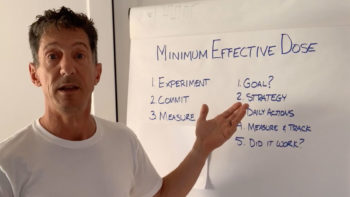You’ve probably heard the phrase “minimum effective dose” before, usually in the context of how much of a certain prescription you should take to get the job done.
Taking too little won’t help the problem, but taking too much could cause unwanted side effects. So the minimum effective dose is the ideal amount.
But now, think about this in the context of the rest of your life (and the Whole Life Challenge). Wouldn’t it make sense to do what’s required to give you the result you want — nothing more, nothing less?
The mistake most of us make is that when we want to make a change in our health or fitness, we look at how far we are from where we want to be, and then we make one of two decisions:
- The gap between where we are and where we want to be is so great, and the effort required to make the change seems so big that we deem it impossible, and we settle for what we have.
- We see the gap just as big as above, but instead of settling, we opt for making a change and we make it big. We take on a massive diet, a cleanse, or calorie restriction. We sign up for a workout program that’s an hour or more per day. Like I said, a big change.
Both of these decisions often lead to failure. In Case 1, we never start. And in Case 2, we make such a big change, that two weeks in, we can’t sustain the new effort, so we give up and decide that we weren’t cut out for the change to begin with (think New Year’s resolutions).
A better approach would be to think about the “minimum effective dose.” What’s the smallest amount that you need to do to get the needle moving?
A few rules to consider when using this approach (which are also covered in the video at the top of this page):
- You must be willing to experiment. You’re not necessarily going to know whether the small thing you’ve committed to changing will have the impact you want it to, but you need to start somewhere.
- You need to commit. No experiment is going to work if you’re not committed to sticking with the change over time. Hopefully you’ve chosen something small enough that it’s doable; now you need to set things up in your life so that you remember to do it and then follow through with it.
- You must measure. How do you know if you’re moving the needle in the right direction if you don’t have a way to measure progress? What does progress look like for you? Is it just being successful each day doing the thing you committed to? Or is it seeing a result after 6 weeks? Either way, you must decide what the measurement is and what will make you feel happy with your progress.
I’ve put together a little formula for you to use — something that you can think through or write down anytime you want to use this strategy for something. Ask yourself these five questions each time and you’ll set yourself up for massive success in this area.
- What’s the goal?
- What’s your strategy?
- What are the daily actions you’re going to take to get there?
- How are you going to measure and keep track?
- Was it effective? Did it give you the desired result?
Now let’s try some examples…
With Food:
- Goal: To eat better snacks each day.
- Strategy: Get rid of all crappy snack food in house; make a list of snacks I like and stock them in fridge/pantry
- Actions: Eat good snacks each day that are easily available in my house or from what I take with me to work
- Measuring: Track success daily in journal (yes or no)
- Effectiveness: Evaluate after six weeks. Was I able to stick with it? Can I still?
With Exercise:
- Goal: Improve push-up strength
- Strategy: Do at least 20 push-ups every day before 7 a.m. (and put it in my calendar)
- Actions: 20+ push-ups per day
- Measuring: Do a max set today and do it again in six weeks. Keep track of daily progress in journal
- Effectiveness: Can I do more push-ups after six weeks?
With Mobility:
- Goal: Improve hamstring flexibility
- Strategy: Do a standing hamstring stretch each evening when watching TV
- Actions: 10 minutes per day, any hamstring stretch I want to do. Do it while watching TV
- Measuring: Measure how far my fingertips are from the floor when I bend over at 7 p.m. after work. Remeasure this in 6 weeks. Keep track of doing the work in my journal every day with yes/no.
- Effectiveness: Retest in six weeks. Am I more flexible?
With Sleep:
- Goal: Spend more time sleeping in bed
- Strategy: Get 15 more minutes of sleep per day by going to bed 15 minutes earlier
- Actions: Set a bedtime alarm that is 30 minutes before the time I should be in bed to remind me to start shutting it down
- Measuring: Write down bedtime every day in my journal (yes or no)
- Effectiveness: Count the number of days I succeeded in getting to bed earlier at the end of six weeks
Give it a try for yourself and let me know how it goes!
For more exercise and Whole Life Challenge-related tips, follow me on Instagram (@andypetranek). I’ll be doing regular Q&As there — look for them in my Instagram stories!






